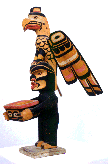
A BRIEF HISTORY OF NORTHWEST COAST NATIVE ART

A BRIEF HISTORY OF NORTHWEST COAST NATIVE ART
 Although there are precious few intact prehistoric northwest coast wood carvings, there are many examples of carved stone and bone that have stood the test of time. From these objects we can get an idea of how far back these designs and images come from. It seems that the true roots of this art form will never be ascertained and will remain lost in time. But some set of circumstances occurred that gave birth to an art form that still flourishes today.
Although there are precious few intact prehistoric northwest coast wood carvings, there are many examples of carved stone and bone that have stood the test of time. From these objects we can get an idea of how far back these designs and images come from. It seems that the true roots of this art form will never be ascertained and will remain lost in time. But some set of circumstances occurred that gave birth to an art form that still flourishes today.
Stone carvings have been unearthed, carbon dating to 6000 years ago, that display many of the forms that make up Northwest Coast design. Bone carvings 1000 - 3000 years old are decorated with the same ovoids and split U's that are incorporated in today's contemporary work. The oldest found carved Northwest Coast wooden object was discovered in 1983 at the mouth of the Hoko River a few miles east of Neah Bay in Washington State. This object, probably a handle for some sort of tool, is identified as being from the Makah tribe and carbon dates to 770 B.C., almost 3000 years ago. The Coast Salish two-dimensional design style of this piece demonstrates how long ago these designs were already developed and in use by Northwest Coast people.
 After contact many old masterpieces made their way to Europe and can be found in museums there. Some of the oldest wooden pieces were collected in 1778 by Captain James Cook and taken to England. Although the 19th century is considered the early classic period of Northwest Coast art circumstances were conspiring that would almost destroy an art form and culture that had survived for thousands of years. The ravages of European disease and the advent of Christianity culminated in the 1880's when the Canadian government declared the potlatch and other ceremonial gatherings illegal. These laws were repealed in 1951 but not before much cultural damage had been done.
After contact many old masterpieces made their way to Europe and can be found in museums there. Some of the oldest wooden pieces were collected in 1778 by Captain James Cook and taken to England. Although the 19th century is considered the early classic period of Northwest Coast art circumstances were conspiring that would almost destroy an art form and culture that had survived for thousands of years. The ravages of European disease and the advent of Christianity culminated in the 1880's when the Canadian government declared the potlatch and other ceremonial gatherings illegal. These laws were repealed in 1951 but not before much cultural damage had been done.
During this time a handful of artists worked, often in secret, to preserve and pass on the art and culture of their people. Kwaguilth artists Charlie James, Willie Seaweed and Mungo Martin and Haida artist Charles Edenshaw worked to preserve the carving and potlatch traditions. After the repeal of the anti-potlatch laws a tourist market again began to develop in Victoria. This sparked a renewed interest in the art form among native people.
Today Northwest Coast art is a growing and evolving art form. With more talented artists than ever before the market place has expanded globally. Collectors from all parts of the world have created a demand for pieces of high quality and authenticity. Artists are exploring new materials and techniques. Culturally the native people of the Northwest Coast are becoming more involved in their own traditions. The future of the art form is as clear as it's origins are mysterious. We are at the dawning of a golden age of Northwest Coast Native art
Pictures: top - Model pole by Mungo Martin circa 1950
bottom - Model pole by Charlie James circa 1920
Copyright Coghlan Art 1998